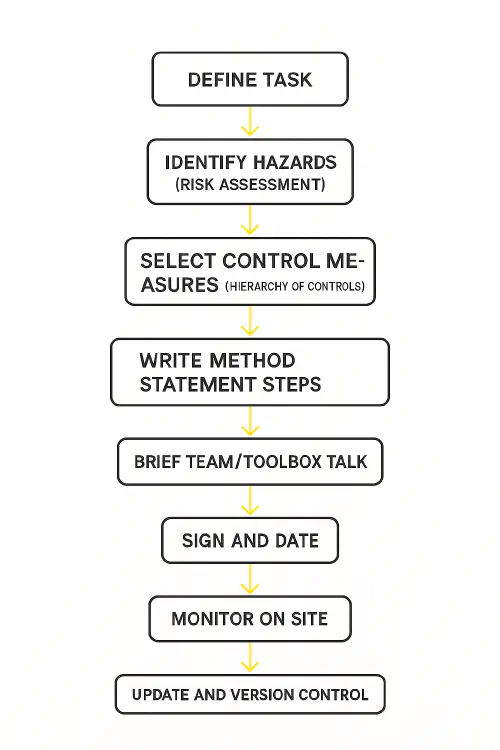
Method statement template for small works and maintenance: free example and how to brief your team
Method statement template for small works and maintenance: free example and how to brief your team
Category: Templates & Resources • Niche: Method statements, RAMS, site safety
Contents
- Quick answer
- What HSE expects and when to use a method statement
- Downloadable-style template you can copy
- How to complete it in 15 minutes
- Briefing the team: a 5 minute toolbox talk
- File naming, version control and storage
- Useful links and references
- FAQ

Site manager holding a method statement checklist on a UK construction site
Quick answer
- A method statement explains how you will carry out a task safely and in the right sequence. Paired with a risk assessment, it becomes RAMS.
- For small works and maintenance, keep it short: scope, hazards, controls, step-by-step method, PPE, responsibilities, emergency plan, sign-off.
- Use the template below and brief your team before starting. Keep signed copies on file, update versions when methods change, and attach photos if controls are site-specific.
What HSE expects and when to use a method statement
Method statements are not a legal requirement by themselves, but risk assessments are. On construction work, a simple, clear method statement helps demonstrate you have planned the job safely and controls are in place.
- HSE on method statements: a method statement describes, in a logical sequence, exactly how a job is to be carried out with control measures and resources to secure health and safety. See HSE’s guidance on Administration.
- Risk Assessment vs Method Statement: risk assessments are required by law; method statements are widely used to show how the controls will be applied in practice. See CHAS.
- Who prepares it: a competent person familiar with the task and the site. See Praxis42.
Related Academy guides you may find useful:
- Dynamic risk assessment on site: a simple POWRA that crews actually use
- Construction site induction video: script, kit and a simple process that meets CDM
- How to set up QR code site induction and CSCS Smart Check that records checks
- Right to work checks on construction sites: what site managers must do in 2025
Downloadable-style template you can copy
Copy this into Word or Google Docs, fill in the grey sections, and save as PDF for issue and sign‑off.
METHOD STATEMENT – SMALL WORKS / MAINTENANCE
Project / Site: ________________________________ Date: ______________
Task / Activity: _______________________________ MS Ref: ____________
Prepared by (competent person): ________________ Company: ___________
1. SCOPE
Brief description of task, area, and interfaces with other trades.
2. RELATED RISK ASSESSMENT(S)
RA Ref(s): __________________ Residual risk after controls: Low / Med / High
3. RESPONSIBILITIES
Supervisor: __________________ Operatives: ___________________________
Permit to Work needed? Y / N Issued by: _____________________________
4. PLANT, TOOLS, MATERIALS
List key items: _________________________________________________
Check certification/inspections in date: Y / N
5. PPE
Mandatory: Hard hat, hi‑vis, safety boots. Task‑specific (e.g., cut‑resistant gloves, eye protection, hearing protection, RPE to ______ standard).
6. SEQUENCE OF WORKS (STEP‑BY‑STEP)
1) Arrival and site sign‑in; confirm induction and RTW complete.
2) Dynamic risk check / POWRA; isolate services as required (LOTO).
3) Set up barriers and signage; keep public and other trades segregated.
4) Carry out task steps safely (detail your method here):
- ___________________________________________________________
- ___________________________________________________________
5) Clear area, remove waste, reinstate services, housekeeping.
6) Hand back, test, and record completion.
7. CONTROL MEASURES
- Access and egress: ____________________________________________
- Isolations/LOTO: _____________________________________________
- Dust/noise/vibration controls: _________________________________
- Work at height (if any): ______________________________________
- Manual handling: _____________________________________________
- Public protection/traffic: _____________________________________
- COSHH/Substances: SDS available? Y / N Controls: ______________
8. EMERGENCY ARRANGEMENTS
First aider: __________________ Location of first aid kit: ________
Nearest A&E: __________________________________ Postcode: ________
Spill/fire/incident reporting: ____________________________________
9. SIGN‑OFF / TOOLBOX BRIEF
Briefed by: __________________ Date/time: _________________________
Names & signatures of operatives: _________________________________
Version: v___ Valid until: __/__/__ Rebrief if method changes.
How to complete it in 15 minutes
- Define the task clearly. State what is in and out of scope so the team does not improvise mid‑job.
- Pull your latest risk assessment. Keep the method statement focused on how you will control the residual risks from the RA.
- Sequence the job. Write the steps as if you are explaining them to an apprentice. One line per step is fine.
- Choose controls using the hierarchy: eliminate, substitute, engineer, admin, PPE. Note isolations and permits early.
- Add site specifics: where the first aid kit is, nearest A&E postcode, location of shut‑offs, access routes.
- Brief and sign. Do a quick toolbox talk, check understanding, and get signatures. Re‑brief if anything changes.

Simple RAMS workflow diagram for UK construction
Typical small works examples to adapt
- Isolating and replacing a kitchen sink trap in a tenanted flat
- Testing an emergency light and replacing a failed fitting in a stairwell
- Swapping a domestic boiler PCB after fault diagnosis
- Patching a section of plasterboard ceiling after a leak
For each, your steps and controls will shift slightly, but the template stays the same.
Briefing the team: a 5 minute toolbox talk
Use this quick script:
- Today’s task is [task] in [area].
- Main hazards: [list 2–3]. Our controls are [barriers, isolation, PPE].
- Sequence: [3–5 key steps]. Do not deviate without checking with me.
- Nearest first aid and emergency plan: [location, who to call].
- Questions and checks. Everyone happy with the method? Sign here.
Tip: Print the one‑pager and clip it to the job pack or attach to the digital job in your field app.
File naming, version control and storage
- Name files like: MS‑[Client]‑[Site]‑[Task]‑v1‑2025‑09‑23.pdf
- Store signed copies with job records and photos. If you operate multiple sites, keep a “Master” template in your document library and clone it per job.
- Update the version whenever you change the method or controls. Keep old versions for audit.
- Link RAMS to induction and permits so your “golden thread” of evidence is complete.
Useful related reads in the Academy:
Useful links and references
- HSE on method statements and planning work: HSE Construction – Administration
- Risk assessment vs method statement overview: CHAS
- Purpose and competency: Praxis42
- Free RAMS template example: HandsHQ
- Short explainer video: HSEDocs – What Is A Method Statement And How To Write One
FAQ
Do I always need a method statement for small jobs?
Not always by law, but many sites and clients insist on RAMS before you start. If the task has any significant risk or you are working under CDM, write one. It can be one page.
Who should sign the method statement?
The supervisor leading the work should brief and sign it. Each operative confirms they have been briefed and understand the method by signing the attendance box.
How long should a small works method statement be?
One or two pages is enough. Focus on the specific site controls and clear steps rather than generic filler.
Can I reuse a method statement?
Yes, but treat it as a master and adapt it for each site. Update hazards, controls, and emergency details, then version and brief again.
What about COSHH?
If you are using substances, attach the SDS and state the control measures in the “Control measures” se…